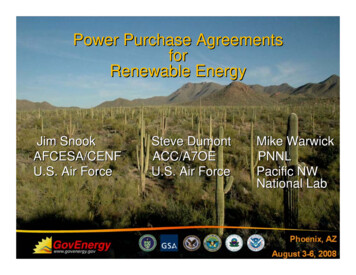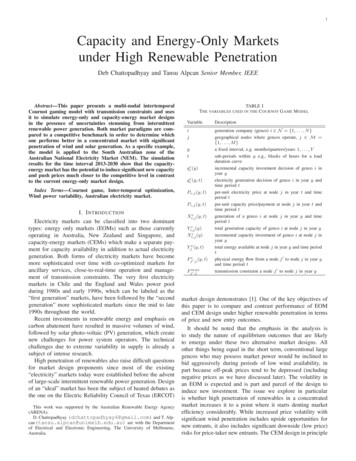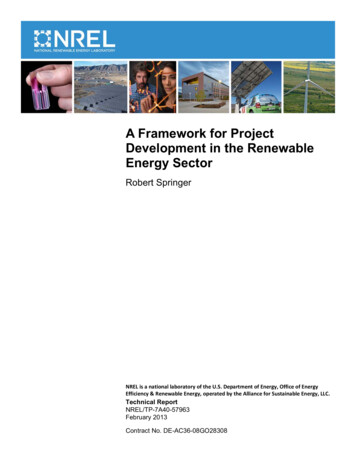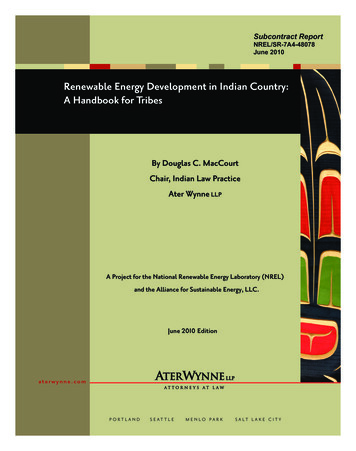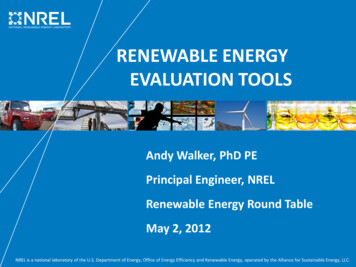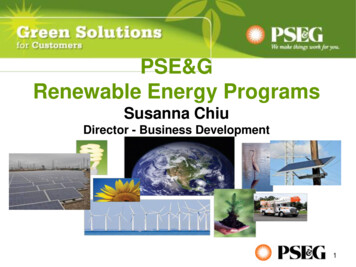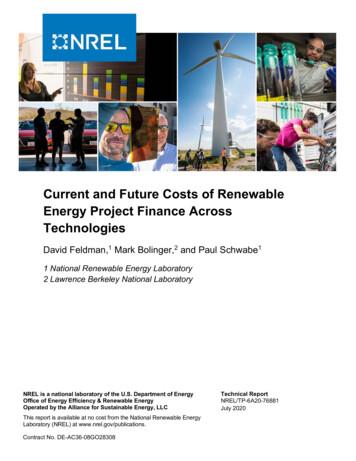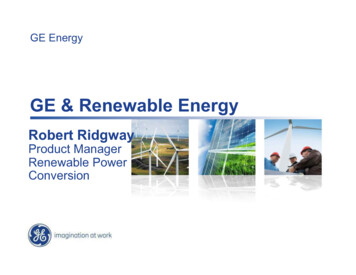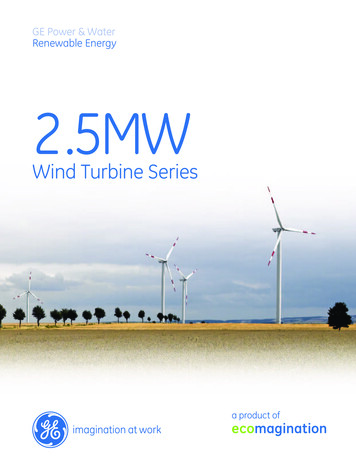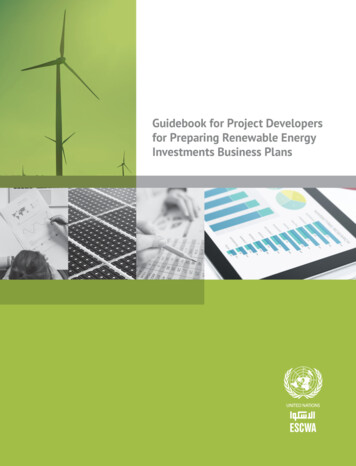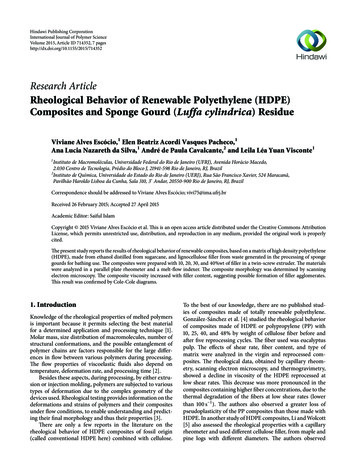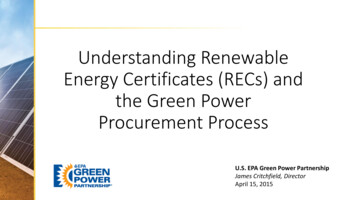
Transcription
Understanding RenewableEnergy Certificates (RECs) andthe Green PowerProcurement ProcessU.S. EPA Green Power PartnershipJames Critchfield, DirectorApril 15, 2015
Webinar Logistics Attendees are muted to reduce background noise. Submit questions in writing via the online control panel. To minimize or maximize the control panel, click on thebutton at the top left of the tool bar. Post-webinar survey on this webinar and topics for futuresessions. Presentations are posted to EPA’s GPP website:http://epa.gov/greenpower/events/15apr15 webinar.htm
What is green power?Biogas Subset of renewable energy - representative of resourcesand technologies that offer the highest environmentalbenefitBiomassWind Electricity generated from natural resources thatreplenish themselves over short periods of time, includingthe sun, wind, moving water, organic plant and wastematerial (biomass), and the Earth’s heat (geothermal)SolarLow-Impact SmallHydroGeothermal Must be from “new” facilities placed into service withinlast 15 years or those that have been repowered Must be of the “voluntary” market Incremental to or Above-and-beyond compliance marketrequirements (e.g., cannot be used for regulatory requirements)
What is a Renewable Energy Certificate (REC)? A Renewable Energy Certificate (REC) is the legal instrument that conveys to itsowner, the right to claim the associated environmental attributes of its generatingresource In essence a REC represents the “renewableness” of the power A REC is created for every megawatt-hour of renewable electricity generated anddelivered to the utility grid A REC generally includes the following information: Type of renewable resourceLocation of renewable resourceDate stamp or vintage of generationEmissions profile of the generating resourceUnique identification number
Why are RECs important? RECs are the currency of renewable energy markets Both compliance & voluntary marketsAllow access to, allocate, and claim use of renewable generation on a shared grid Influence electricity market dynamics by allowing the expression and aggregation ofconsumer preferences for specific forms of electricity generated from renewables REC procurement reduces available REC supply sending a demand signal to the market todevelop more supply Incent new renewable energy project development Voluntary users can qualify their preference for specific renewable technologiesStates can spur development through mandated programs (SREC programs) Instrument through which renewable energy and environmental claims aresubstantiated Why do you buy green power?What are you wanting to claim? Tool used for meeting corporate goals for greenhouse gas reporting as well as forstate policy mandates under Renewable Energy Portfolio (RPS) standards
Green Power Supply Your choices: Buy unbundled RECsBuy a green power product from an electricity service provider (bundled REC product)Own, operate, generate and consume green power from an onsite project (with RECs)Buy green power through a power purchase agreement (with RECs) with an onsite projectBuy green power through a power purchase agreement (with RECs) with an offsite project All green power supply options involve RECs A REC generated from an onsite project is no different than a REC generated from on offsiteproject Buying RECs alone may be the only reasonable option in some situations National footprint Leased space situations Poor market conditions for developing projects Electricity use from a renewable resource in the absence of owning the associated RECsis not considered renewable electricity (referred to as “null power”) and has the sameenvironment profile as the residual grid electricity mix – RECs make it renewable!
RECs and environmental claims REC ownership allows you to claim that you are using renewable electricity Once a claim is made, the RECs are retired REC ownership signifies that your electricity was generated by a zero emissionsresource REC ownership does not represent a direct emissions reduction or an avoidedemission claim. RECs and not offsets! Substantiation of your claims is necessary (See FTC’s Green Guides and the NationalAssociation of Attorneys General Guidance)
Do RECs deliver clean renewable electricity? Electricity on the grid does not flow like water through a hose Don’t think of electricity (the electrons) as either clean or dirty. On ashared grid, electricity looks the same no matter its source The relative cleanliness of your electricity has to be evaluated at the pointof generation to see how the generator impacts the environment Air pollution and greenhouse gas emissions are emitted at the point of generationfor every megawatt-hour produced by conventional fossil fuel-based power plants Renewable resources don’t emit anything as a consequence of generating electricity Air pollution cannot be delivered through the grid RECs contractually deliver ownership of renewable energy when theelectrons you receive do not tell you anything about the way your powerwas generated
Physical Grid vs Contractual Pathways
REC Video
When and how you engage a projectaffects the claims you can makeProject ownershipRenewable Energy Certificate off-takeFinanceable long-term commitmentUndifferentiated electricity off-takeTimeProject Build DatePre project engagementPost project engagementProject EngagementMarket EngagementDirect impact on new supplyDirect impact on new demandClaim: I use renewable electricity I helped develop new renewable energy supplyClaim: I use renewable electricityProcurement Options: Own and build a project (keep RECs) Direct long-term financeable commitment (i.e.,PPA) with new project (keep RECs)Procurement Options: Contract with utility suppliers (keep RECs) Unbundled RECs
Options for increasing one’s impact through Green Power Buy more Buy long-term Buy from yet to be built projects Take an equity position in new projects (off-site) Own or host on-site projects
Procurement and Best Practices1. Determine scope of entity to be covered (facility, organization-wide, etc)2. Determining your electricity use (owned and leased operations)3. Determine time period you want to cover with REC purchase and what the RECvintage needs to be4. Determine the quality and content of your green power purchase5. Buy a third-party certified and verified product6. Identify and research green power providers7. Reach out to numerous providers for quotes or issue RFP8. Purchase and announce your green power use to stakeholdersNote: The above process is focused on the procurement of unbundled RECs
Procurement Process and Best Practices Determine the scope of entity to be covered (facility, group offacilities, organization-wide, etc.)Single Facility (i.e. HQ)Group of Facilities (i.e.New York operations)Scope of electricity use:Scope of electricity use:2 million kWh per year4 million kWh per yearBuilding Portfolio (i.e. U.S. operations)Scope of electricity use:8 million kWh per year
Procurement Process and Best Practices Determine your electricity use at your given scope Look at your utility bills or contact your power provider(s) If leasing office space, base your energy use on 14.9 kWh/sq ft200 𝑓𝑡.100 𝑓𝑡.200 𝑓𝑡. 100 𝑓𝑡. 4 𝑠𝑡𝑜𝑟𝑖𝑒𝑠 80,000 𝑠𝑞. 𝑓𝑡.80,000 𝑠𝑞. 𝑓𝑡. 14.9 𝑘𝑊ℎ 𝑝𝑒𝑟 𝑠𝑞. 𝑓𝑡. 𝟏, 𝟏𝟗𝟐, 𝟎𝟎𝟎 𝒌𝑾𝒉 𝒑𝒆𝒓 𝒚𝒆𝒂𝒓
Procurement Process and Best Practices Determine the time period you want to cover with a REC purchase Fiscal year vs Calendar year vs 12-month period Retrospective vs Prospective Consider your green power delivery schedule Quarterly, Bi-annually, Annual, with/with out a true-up Prospective buying generally involves an end of year “true-up” to accuratelymatch your green power purchase with your actually energy use Ensure the simultaneity of the relative vintage of your green powergeneration with the operating period of your electricity consumption
Procurement Process and Best Practices Determine the quality and content of your green power purchase What resource type do you want?What geographical origin do you want your purchase sourced from?How long a procurement commitment do you want to make?What type of supplier/vendor do you want?What other special attributes you are interested in prescribing? Project specific RECs Solar sourced from K-12 grade schools Wind sourced from farmers REC price is a function of supply and demand which varies by factorssuch as resource type, geography, and length of commitment
Procurement and Best Practices Buy a third-party certified and verified product Buying certified and verified green power products is a consumer best-practice Certification answers the question "Does this product meet acceptable standards forquality?" Certified products meet widely accepted consumer and environmental standards Certification ensures the quality of a green power product, but also validates the product'senvironmental attributes Certification includes standards of conduct for ethical behavior, including marketing claims bysuppliers, and requires regular reporting to monitor these claims Verification answers the question "How do I know I'm getting what I pay for?" Third-party certification usually carries a requirement for independent verification todocument that the amount of green power generated equals the amount of green power soldto customers Third-party independent auditors verify that the green power behind the product wasproduced and placed on the utility grid and helps verify the product's environmental benefit Verification serves as a form of buyer protection against deception or fraud
Procurement and Best Practices Identify, research and contact green power providers
Procurement and Best Practices Purchase and announce your green power use to stakeholders"Our renewable purchase is just onepart of a multi-faceted approach toprotect the environment, and onethat we hope spurs additionaldevelopment and demand forrenewable energy.“ – Marty Sedler,Intel, Director, Global Utilities andInfrastructure“Green power purchases are aneffective and important way we canimplement renewable energysources to reduce our carbonfootprint. As an EPA SustainedExcellence Award winner, we haveincreased our purchases companywide, achieving 100 percent greenpower in 2010, 2011 and 2012. Weare pleased to have extended thiscommitment through 2015.” - KenBonning, Kohl's Department Stores
Summary RECs are the currency of renewable energy markets RECs are legal instrument that allows one to claim to be using renewable electricity Claims of using renewable electricity must be substantiated RECs are inherent in all green power procurements; from unbundled RECs toinvesting in your own RE project You must retain the RECs associated with onsite projects in order to claim to be usingrenewable electricity RECs are used by organizations as a tool to reduce their carbon footprint (scope 2emissions) RECs are not offsets – different instruments for different applications and claims Green power purchases can be customized based on several criteria (i.e., resource,geography, supplier, term etc.) Organizations are looking beyond basic renewable electricity claims to also usingtheir procurement to directly build new projects EPA recommends buying certified and verified green power products as a bestpractice
For more information Green Power Partnership – www.epa.gov/greenpower Contact info: James CritchfieldGreen Power Partnership202-343-9442critchfield.james@epa.gov
Verification serves as a form of buyer protection against deception or fraud. Procurement and Best Practices Identify, research and contact green power providers . Procurement and Best Practices Purchase and announce your green power use to stakeholders “Green power purchases are an effective and important way we can implement renewable energy sources to reduce our carbon footprint .
